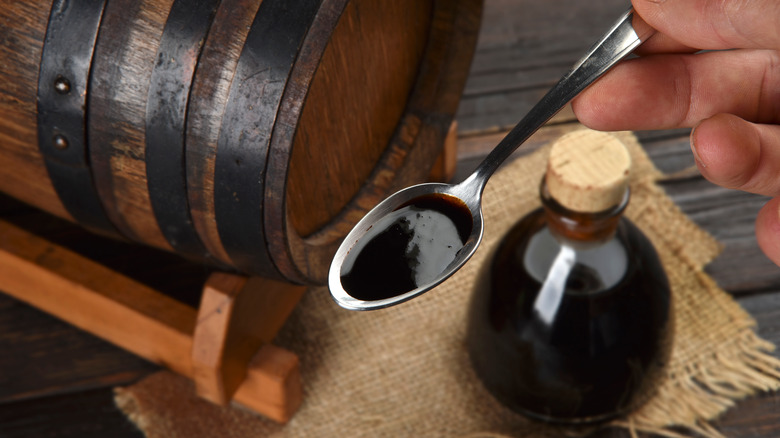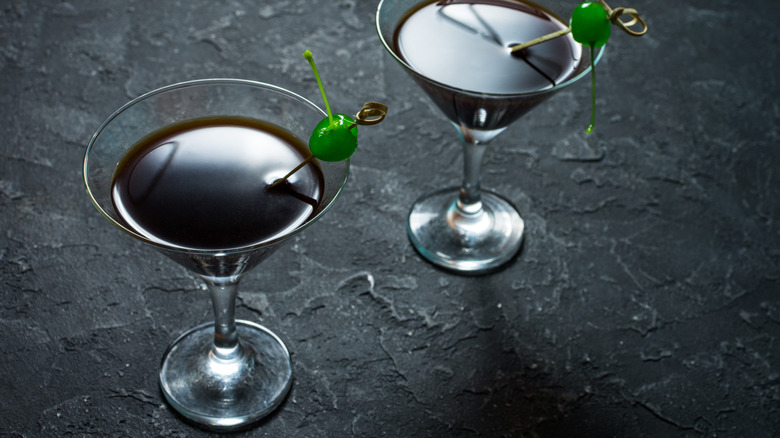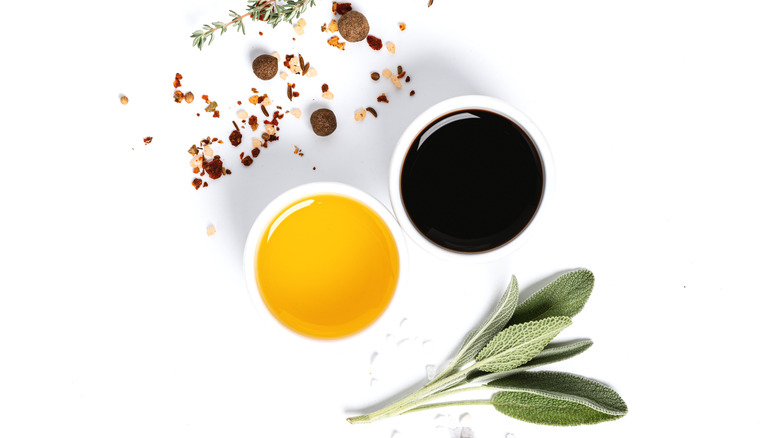The Number One Tip For Using Balsamic Vinegar In A Cocktail
Yes, really. Don't knock it till you try it. The modern mixologist laments versatile balsamic's tragic affiliation with such limiting arenas as salad dressing and Italian food, exclusively. Balsamic just might be the secret ingredient your cocktail is missing.
Balsamic vinegar is made from pressed grapes, which are then concentrated, fermented, and acidified, says Simply Recipes – which isn't all too dissimilar from the wine-making process. Also similar to wine is balsamic's top flavor notes (fruity, sweet, dark), but the vinegar adds an acidic punch that can help neutralize harsher citrus notes.
Cameron Winkelman, head bartender at New York City's Manhatta, praises balsamic for adding "depth of flavor," according to Punch, and even personally using the ingredient in blueberry shrub. Per beverage purveyor, Shivelight, a shrub is a muddled or thick, blended liqueur base (usually involving fruit or other natural ingredients), on top of which liquor and/or a mixer like soda water or ginger ale is added to form a cocktail. Shrubs can add a dimensional flavor and textural component to your drink — not to mention they're visually impressive in the bottom of a crystal rocks glass.
Jerry Slater, career restaurateur and inventor of the Bufala Negra, created the cocktail by muddling balsamic, bourbon, and basil with ginger ale, via Southern Foodways Alliance. (The New York Times even did a write-up on the balsamic-forward cocktail.) Balsamic is a shrub superstar, but that isn't where its abilities in the cocktail world end.
Balsamic is a backbar superstar
Stuart Weaver, general manager of Denver's Lady Jane, praises balsamic for its "beautiful, rich, complex dark fruit notes," which Weaver highlights by pairing it with blackberries in his cocktails (via Punch). Indeed, just as in salads, balsamic is a fitting complement to a fruity drink. Yummly recommends using balsamic in a Sparkling Grapefruit Cocktail, a recipe reminiscent of the simple Paloma: largely just tequila and grapefruit soda. (Makes balsamic cocktails not seem like such unfamiliar terrain, huh?) For a balsamic-infused Paloma, Milagro Silver Tequila with its slightly sweet 100% blue agave base would act as a fitting liquor.
But, rest assured, if you aren't a bourbon or tequila fan, balsamic can still work for your drink. Mixology platform, CraftTender, created The Black Dahlia, featuring a balsamic reduction, lemon juice, peach liqueur (to counteract the acidity), and gin. The sweet sharpness of the balsamic and the understated citrus would likely be complemented by a dryer gin like Tanqueray No. 10, with additional botanical notes.
However, balsamic doesn't just work for fruity drinks. Vodka giant, Absolut, created the May Be Hot cocktail: a simplified take on a classic Bloody Mary. Miami's Valentino Longo (who won Most Imaginative Bartender of 2020, per Punch) created a variation of the Espresso Martini using rum, amaro, a coffee foam head, and a reduction made from balsamic and Fernet-Branca – the industry worker's cordial of choice. So, how can at-home mixologists make balsamic work for their own cocktails? Here's the number one tip.
A little goes a long way
As in many arenas behind the bar, moderation is the name of the game. When it comes to balsamic, "Eat Your Drink" cocktail cookbook author, Matthew Biancaniello, says, "[A]s soon as you can taste it, it's too much," via Punch. However, Biancaniello also advocates for balsamic as a primary ingredient rather than as a condiment — even in the cocktail world. "Don't be afraid of flavor. Don't be afraid of letting that balsamic shine." It's a balancing act.
Even award-winning bartender, Jillian Vose (former bartender at NYC's The Dead Rabbit), admits that fans were initially skeptical when she created the unconventional Emilio Sour: a mix of gin, grapefruit sherbet, celery seed syrup, lemon juice, chocolate bitters, and chili-infused balsamic vinegar, via Thrillist. However, Vose says the payoff was well worth the risk: "It was really cool to make something that was built around the vinegars, as opposed to the vinegars being an accent," Vose explains. "You have to think about it not being too harsh on the stomach, something that's palatable for a full cocktail. Though it's not a new trend, perse, it's getting more popular as people gain access to high-quality vinegars."


